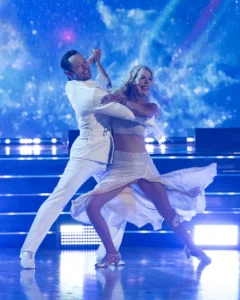Tori Spelling recently shared her excitement about joining *Dancing with the Stars*, but her foxtrot performance has sparked mixed reactions online. Public criticism is something the actress is familiar with, and this time was no different.
At 51, Spelling took to the *Dancing with the Stars* stage with grace and confidence, performing a foxtrot with her dance partner, Pasha Pashkov. The duo impressed many in the audience with their elegant routine. Her debut was especially meaningful as she had the support of her former *90210* castmates.
Despite the positive reactions, some viewers voiced concerns and critiques on social media, sharing mixed opinions about her performance.

For her ballroom debut on September 17, Tori Spelling wore a gorgeous, sparkly dress that featured sheer fabric around her midriff. She paired the flowing gown with glittery heels and styled her blonde hair with two braids on the sides, letting the rest fall in soft curls.
Together with her dance partner, Pasha Pashkov, the pair performed their routine to P!nk’s song “Trustfall.” Throughout the performance, Spelling smiled brightly as she spun, swayed, waltzed, dipped, kicked, and shimmied across the stage, following Pashkov’s lead and sticking to their choreography.
After the performance, social media users shared their thoughts. Instead of focusing on her dance skills, some expressed concern for Spelling’s health and wellbeing.

On the other hand, many viewers focused on Tori Spelling’s dancing. One observer criticized, “Awful performance.” Another commenter mentioned her enthusiastic facial expressions, saying, “Her face and voice don’t match she needs more practice .”
Some also questioned the difficulty of her routine. A YouTube commenter remarked, “Her choreography was way easier than most other dancers, not really fair to the other dancers.” Another added, “That was tough! Bless her heart, at least she looks happy?
Despite the criticism, some fans thought Spelling did a great job. One viewer, unhappy with the scores, commented, “She deserved better scores! Why was she undercut? Such beauty to her routine!!”

Among those showing support for Tori Spelling are her former *Beverly Hills, 90210* co-stars: Brian Austin Green, Gabrielle Carteris, Jennie Garth, and Ian Ziering.
Before her *Dancing with the Stars* debut, her co-stars shared how excited they were for her to compete for the Mirrorball Trophy on season 33. At the *90210* panel during 90s Con on September 14, they offered words of encouragement. While they all agreed that the show is challenging, they wished Spelling the best. Green, who had competed on *DWTS* himself, advised, “Keep your head on, enjoy the experience.”

On the night of her foxtrot performance, Spelling gave a brief interview with *Extra* where she explained why she finally decided to join the show. She shared that while she had turned down the offer in the past, it wasn’t because she wasn’t a fan—she confirmed that she’s always been a big fan of the show.
This acknowledgment in her book contrasts with a 2013 interview with *Us Magazine*, where Tori Spelling highlighted her bikini body and discussed her weight loss journey. In that interview, she stated, “I feel like I took off the weight safely, and I’m totally happy here,” reflecting the complex pressures celebrities often face in presenting an idealized image of health and fitness. This shows how public figures can feel torn between personal struggles and the need to maintain a perfect image.
Synaptic Information Storage Capacity Measured With Information Theory
Ever wondered just how much data your brain can hold? We often compare the brain to a supercomputer, but what if that comparison isn’t just a metaphor—it’s literal? Deep within your brain, at the junctions where neurons meet, lies an extraordinary form of biological storage: the synapse. And thanks to breakthroughs in information theory, we’re beginning to quantify its staggering capacity.
In this article, we’ll dive into how synaptic storage works, how scientists measure it, and why this knowledge could shape the future of data storage—from artificial intelligence to DNA-based memory.
What Are Synapses and Why Are They Important?

Think of neurons as the brain’s messengers. But without synapses—the gaps between them where signals are transmitted—those messages would go nowhere. A synapse is where the magic happens: it’s the space where one neuron sends a chemical or electrical signal to another, sparking thoughts, memories, movements, and more.
Now here’s the kicker: each of these tiny junctions doesn’t just pass along data—it stores it.
Your brain has about 86 billion neurons, and each one can form around 1,000 synapses. That’s a total of roughly 125 trillion synapses buzzing away in your brain, constantly sending and receiving signals. These connections form the foundation of your memories, knowledge, and perception.
Measuring Synaptic Storage with Information Theory
To understand how synapses store information, scientists turn to information theory—a branch of mathematics that deals with encoding, decoding, and compressing data. Think of it like analyzing how much a hard drive can hold, but on a biological scale.
Video : 2-Minute Neuroscience: Synaptic Transmission
Each synapse, as it turns out, can store up to 4.7 bits of information. That might not sound like much until you consider the scale:
- 1 bit is a single piece of binary data (a 0 or 1)
- 4.7 bits per synapse × 125 trillion synapses = over 500 trillion bits of potential storage
Translated into digital terms, your brain can theoretically store more data than the entire internet—all in a compact, low-energy package powered by biology.
The Brain’s Efficiency: Powering Trillions of Connections
Here’s something even more mind-blowing: while your laptop heats up and guzzles electricity, your brain handles all of this complex storage and processing using roughly 20 watts of power—that’s about the same as a dim light bulb.
This insane efficiency is what’s inspiring researchers to build neural networks and deep learning systems that mimic the brain. If computers could process and store data like synapses do, we’d have faster, smarter, and greener technology.
Artificial Intelligence and Synaptic Models
The field of AI, especially machine learning and deep learning, borrows heavily from how the brain processes and stores information. Artificial neural networks use layers of interconnected nodes (inspired by neurons) to simulate learning.
But here’s where it gets interesting: researchers are now using real data about synaptic information capacity to refine these systems. The goal? To build AI models that are more human-like, not just in intelligence but in efficiency and adaptability.
Imagine a future where your smartphone thinks and stores information with the same elegance as your brain. That future isn’t science fiction—it’s science.
Beyond the Brain: DNA as the Ultimate Storage Device
While the brain remains the pinnacle of biological storage, it’s not the only game in town. Enter DNA, nature’s original information vault.
DNA doesn’t just code for life—it can be used to store digital data. And we’re not talking small files here. A single gram of DNA can hold up to 215 petabytes of data. That’s 215 million gigabytes—enough to store every photo, song, and document you’ve ever owned, plus millions more.
In fact, researchers have already done it. In one groundbreaking study, scientists encoded a 52,000-word book into synthetic DNA. They converted the digital content into binary (0s and 1s), then translated those digits into DNA’s four-letter alphabet: A, T, G, and C. The result? A physical strand of DNA holding a complete, retrievable digital file.
Why DNA Storage Matters for the Future
Traditional storage devices—hard drives, SSDs, even cloud servers—have physical limits. They degrade over time and take up massive amounts of space. DNA, on the other hand, is incredibly compact, durable, and stable for thousands of years if stored properly.
If scaled correctly, DNA storage could revolutionize how we preserve knowledge. Imagine backing up the entire contents of the Library of Congress on something no bigger than a sugar cube. That’s the level we’re talking about.
Video : How Your Brain Remembers: Neurons & Synapses Explained!
Bridging Biology and Technology
What’s exciting is how these two areas—brain synapses and DNA storage—are starting to intersect. Both are nature’s proof that small-scale systems can handle mind-blowing amounts of data. As scientists continue to decode these systems using information theory, they’re finding ways to integrate them into technology.
It’s not about replacing computers with brains or turning DNA into a USB drive. It’s about learning from nature’s most efficient designs to build the next generation of computing and storage systems.
Conclusion: Reimagining Storage in a Biological World
Your brain’s 125 trillion synapses silently store and process more information than entire server farms, all while sipping on 20 watts of energy. Meanwhile, DNA—the code of life—is showing us how to pack massive libraries of data into microscopic strands.
By measuring synaptic storage capacity with information theory, we’re not just understanding the brain better—we’re laying the foundation for a new era of intelligent, efficient technology.
The takeaway? Nature has already solved problems we’re only beginning to understand. And the more we study it, the closer we get to unlocking the true potential of both our minds and our machines.



Leave a Reply